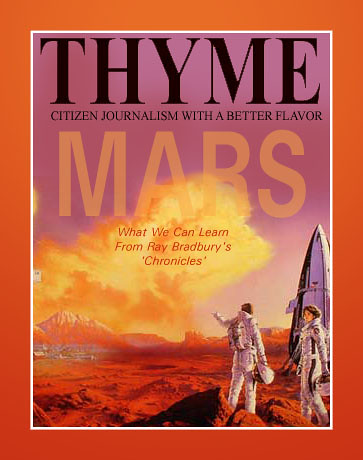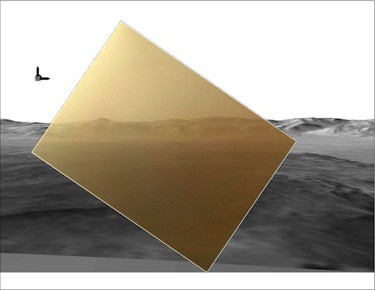
Volume IV, Issue XXXIII
What We Can Learn from Mars
The 'other' news magazine this week muses: What We Can Learn from a Robot 154 Million Miles Away [click to read]. THYME asks: "What can we learn from a novel set 154 million miles away that hits close to home?"
I first discovered The Martian Chronicles in my youth, looking for anything about space, rockets, astronauts and worlds unknown. What I didn't realize when I picked up Bradbury's famous work, was where it would take me.
Written in 1950, the Martian Chronicles carries the darkest fears of a world dominated by the Cold War into a 'future history.' The devastation of Hiroshima and Nagisaki was still in recent memory as the West faced off with a nuclear Russia. Against this background the exploration and colonization of Mars takes place. The meeting of Earthlings and Martians eerily mirrors the meeting of Europeans with Native Americans in the colonization of the New World. Eventually the Native Martians succomb to Chicken Pox, a clear allusion to the animal borne pathogens that killed Native Americans in our own history.
In a 1950's vision of 'green technology,' scientists begin to plant trees and other vegitation to transform the atmosphere of Mars. Eventually the oxygen level is raised, making settlement possible. This settlement strangely resembles the American Midwest in appearance. A trip to Mars begins to resemble a journey to Kansas! The original novel even contained references to American racism. At one point all the African-Americans are preparing to move to Mars, but the reference was later was eliminated from the 2006 William Morrow/Harper Collins, and the 2001 DoubleDay Science Fiction reprinting of The Martian Chronicles.
There was once a museum that had aquired a fine Etruscan horse sculpture in the Nineteenth Century. A hundred years later, a noted art scholar declared it a brilliant forgery. When asked how he came to that conclusion, the expert stated: "The artist has brilliantly copied everything he knows about the Etruscan period... and everything he DOESN'T know about the Nineteenth Century!" Here is where Bradbury's novel is brilliant. Chronicles describes everything Bradbury knows about history mingled artfully with everything he didn't know about his own era.
In the novel the worst of our Cold War fears are realized. Almost everyone returns to Earth and nuclear Armageddon takes place. In an eery passage, the household robots of a vaporized family in Allendale, California dutifully put out breakfast every morning and clean the table afterwards... continuing to serve though their masters are gone. The limits of their programming does not allow them to see the vaporized sillouettes of the family, (a clear allusion to Hiroshima,) in the wall of the house.
The final story in the Chronicles is that of a man who takes his family to Mars in a rocket that was meant to be used in the conflict. He burns his old tax records and papers, destroys the rocket and eschews a 'misguided way of life.' Promising to show his sons a Martian, he takes them to one of the canals where they gaze on their own reflections. They are the new Martians.
I was born a year after Chronicles was first published. The Cold War was clearly a dominant feature of those years. We took the Cuban missle crisis seriously. A trip to the county fair would often include visiting a display on how to build a home fallout shelter. Dad would always interrupt our morbid curiosity about such things and sweep us along to the livestock and the tractors. Still the point was well taken that the world was a dangerous place. When the missle ships turned away from Cuba, our entire class cheered.
Chronicles resonated with the world where I lived and provided a unique mirror in which it could be observed.

Image taken by Curiosity of the Martian Landscape. NASA/JPL Image.





No comments:
Post a Comment